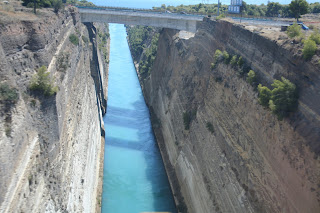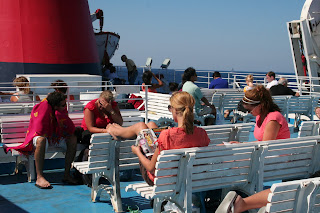The alarm went off at 7.30 and I was up pretty smartly. I
packed everything up, had the quasi-breakfast again and went down to pay the bill
- €120 well spent as the room had TV and air conditioning and a great position.
I walked down to the bus station in about 5 minutes flat and bought a €4.40
fare to Tripoli (TPIΠOΛH) for 8.30. The bus stopped at Argos as usual and most of the people got
off. A handful of us continued on to Tripoli
and the road went up over the mountains in the most amazing collection of
curves and switchbacks I’ve seen for a while. As I was in the front seat it was
a spectacular drive – the rest was very pleasant and rural.
I saw more of the strange glass boxes with religious icons
beside the road. I really thought they were mailboxes for a while, until I
realised some were in completely isolated spots and then, with an ominous
forboding, that many were on the edges of precipices. Most were small, but a
few were grand constructions resembling mausoleums. I decided they could only
be shrines to people who’ve died in road accidents. That means the one on the
edge of the Akronafplia is probably for someone who fell to their death. I
found it a very telling manifestation of the religious nature of Greece as a
country. You would never find such a devout demonstration in Australia.
We pulled in to Tripoli just
before 10am and I set about finding the other bus station for buses to Sparta (ΣΠΑΡΤΗ). It
wasn’t immediately obvious, even with the Lonely Planet description, so I went
to the ticket desk. The woman I asked had sketchy English so she called a man
who came out to me. He directed me left back on to the main road, then right
and down 500 metres. It was a short walk but hot and hard with my bag. An
enterprising taxi driver worked out where I was going and offered to take me
there for €3. No thanks!
I found the bus station (such that it was – just a ticket
office really) and bought a ticket to Monemvasia (MONEMBAΣIA) for €12. The man
there was very nice, telling me I had 15 minutes to wait and specially calling
me when the bus arrived. Mostly old men got on the bus, but there were two
other backpackers with sketchy English who’d done the same walk as me and been
offered the same taxi. I got on and there were no seats. The backpackers sat on
the back steps, and despairing, I went back up the front and decided to try the
driver and sit on the little step beside him. He had reasonable English and
said it was OK. Then I noticed the folded-up tour leader seat on my right and
asked if I could sit on that – he said yes and gave me instructions on how to
open it down. I put the arm rest down, put my seat belt on and found myself
extremely comfortable with a great view. I spent an enjoyable hour driving
through the countryside with enormous mountains on one side and much more
vegetation than previously.
The drivers are totally insane – they don’t stay on their
sides of the road and overtake on the most outrageous blind corners, thinking
that it’s safe if they drive slowly. Horn-honking is compulsory – it seems to
mean ‘I am coming past so don’t deviate from your present course’ or ‘watch
yourself’ or ‘I’m coming around a tight corner on a narrow road and you won’t
see me until it’s too late’. I shouldn’t have been surprised about the shrines
really, should I?
We arrived at the bus
station in Sparta
at about 11.40. Very unfortunately, the first bus to Monemvasia had left at
11.30.
So, determined to have at least one photo of those amazing mountains, I
walked up the street to get two, then back to the bus station. I ordered a cup
of tea and the old man asked if I wanted a frappe (coffee) – I mimed tea, then
a sweet younger man came out and sorted it out in English, telling the old man
‘tzai’. The younger man brought my tea to my table and brought a glass of water
and a big smile as well. I tried two hotels in Monemvasia on the phone – the
best one was closed, and the other one was open and had rooms, but they didn’t
seem to want to take my details. I was pretty sure that I would be OK just
rocking up anyway. I thought to myself what a fascinating, interesting and
enjoyable day it had been so far.
It all went a bit downhill from there when I went to the
toilet 15 minutes before the bus was due at 1.30, and closed the door behind me
before realising there was no handle on the inside. I was well and truly locked
in. There was no one else in the room, so there was nothing for it but to climb
into the next cubicle. Thank god there was a ledge and the dividing wall was
fairly low. I got into the next cubicle, tearing my shorts in the process, then
pushed the door of mine in and got my bag. The bus pulled in shortly after. I
got on and could only get a seat near the middle. The scenery was fairly
ordinary but the driver was a complete kamikaze. A lot of the route was minor
roads through EVERY single village and he was driving pretty fast through some
narrow spaces. I moved to the front of the bus after Skala but still felt a bit
off.
We arrived, and stopped in the middle of the main road in
Monemvasia. It was very hot and very bright and the town was smaller and less
developed than I had expected. I found Hotel Akrogiali by literally looking
around me from Malvasia Travel and a little old lady was waiting outside for
me. She asked if I was the one from on the phone, and she showed me upstairs
and made my bed as I watched. She showed me the key in the door and left me to
it. I walked out to explore the town. I checked bus times to Athens, got a cheese pie from a nice man in a
bakery, and explored the busy metropolis that is Monemvasia. It was windy and
the waves were quite big.
While there were some nice hotels, and nice cafes on
the far side of the causeway, there was still an undeveloped feel about it. The
rock was bigger and wider than I expected. It looked totally barren except for
a few old buildings at the bottom and a glimpse of some sort of fortification
at the top.
I ventured across the
causeway on foot and realised I had a bit of a walk ahead of me. I walked around
the seemingly deserted road, until I came to the fortified wall and entrance,
which made my jaw drop. I walked through the archway and into a dark tunnel,
emerging after two bends in a beautiful street lined with signs and shops. It
didn’t take long to exhaust the shops, bars and tavernas and I headed into the
side streets to look at churches and other things of interest. It was hard to
know which steps were footpath and which led into people’s houses. The
buildings were typical brown brick Byzantine with round roofs, but there were a
couple of island-looking white with bougainvillea. There were lots of cats, and
some stared at me when I turned a corner. The Lower Town
was nice, and amazing to think how old it was, but it didn’t hold an enormous
amount of interest for me.
I headed uphill in search of the Upper Town
and found only houses, piles of rubble and building sites. Then I found the
path up the cliff to the real Upper
Town. Ten minutes and
three archways later, I emerged among the ruins. There is a sign saying to take
care, but it’s outrageously dangerous.

The big church really is on the edge of
a massive cliff and the unwary could easily go over. I didn’t go to the citadel
because the sun was sinking, but I looked at as many things
as I could. I avoided one section beyond a certain point because it was so
close to the edge it was scaring me. I headed down, finding a few new nooks to
explore, bought some worry beds and started back. I got dinner and some cash
and settled in for the night. I decided that I had pretty much exhausted things
of interest in Monemvasia and would leave in the morning rather than the
afternoon. I rang John for advice about Athens
hotels and regretted it because he sounded tired and didn’t have much
information to hand. He said he’d text me back. The whole town lost power at
about 9.30. It came back on at about 10.30 but not before I’d had a cold shower
in the dark. Bed at 11.

















